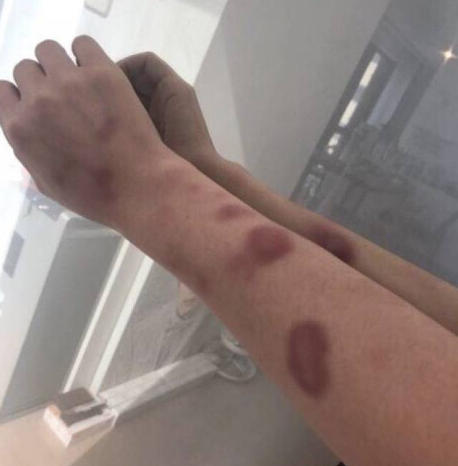
You’re getting dressed and you notice a splash of purple on your arm or leg. You don’t remember bumping into anything. A few days later, another one appears, a faint yellow-green reminder of an injury you can’t recall. It’s a common refrain as we get older: “I must have knocked into the cabinet again.” But when the bruises become frequent, showing up with little to no provocation, it’s more than just clumsiness. It’s a message from your body.
Bruising easily? Your blood is missing… the essential building blocks it needs to form strong, rapid clots, and your blood vessels are losing their protective armor.
Let’s demystify what’s happening. A bruise is essentially a small, contained internal bleed. When you get injured, tiny blood vessels called capillaries break under the skin. To stop the leak, your body launches a complex emergency repair system that relies on tiny cells in your blood called platelets and proteins called clotting factors. They work like a crew patching a hole in a hose, forming a plug to stop the bleeding.
When you bruise easily, it means this repair system is sluggish or the “hose” itself has become fragile. Here’s what might be missing or diminished.
The Missing Pieces: Key Nutrients for Strong Blood Vessels and Clots
- Vitamin C: This is a big one. Think of Vitamin C as the mortar that holds the bricks of your blood vessel walls together. It’s essential for producing collagen, the tough, fibrous protein that gives your skin and blood vessels their strength and elasticity. When you’re low in Vitamin C, the capillary walls become weak and fragile, like an old, crumbling rubber hose. They rupture at the slightest pressure, leading to bruising. This is a classic, often overlooked, sign of a mild deficiency.
- Vitamin K: If Vitamin C is about the vessel wall, Vitamin K is the foreman for the clotting crew. It’s absolutely vital for activating the clotting factors that form a stable plug. Without enough Vitamin K, the clotting process is slow and inefficient. A little leak becomes a much larger bruise because your body can’t patch the hole quickly. Certain blood thinners (like Warfarin) actually work by blocking Vitamin K’s action.
- Bioflavonoids: These are the unsung heroes, often found alongside Vitamin C in citrus fruits and dark leafy greens. They act as antioxidants and work synergistically with Vitamin C to strengthen capillaries and reduce inflammation, making them more resistant to breaking.
The Thinning Shield: Age and Skin Changes
It’s not just what’s in your blood; it’s also what’s around it. As we age, our skin naturally becomes thinner and loses some of its protective fatty layer. This cushioning effect diminishes, meaning minor bumps that would once have been absorbed now transfer more force directly to the delicate capillaries beneath. At the same time, years of sun exposure can damage collagen and elastin in the skin, further weakening the support structure around blood vessels.
When It’s a Sign of Something More
While nutritional deficiencies and age-related thinning are the most common causes, easy bruising can sometimes point to more serious conditions that require a doctor’s attention.
- Liver Disease: The liver produces most of the clotting factors your body needs. If the liver is damaged by conditions like cirrhosis or hepatitis, it can’t produce these factors efficiently, leading to a bleeding tendency.
- Blood Disorders: Conditions like thrombocytopenia (a low platelet count), leukemia, or other bone marrow disorders can directly affect the number or function of the platelets needed to form clots.
- Side Effects of Medication: This is a huge factor for many older adults. Common medications can contribute to easy bruising, including:
- Aspirin and NSAIDs (like ibuprofen and naproxen), which thin the blood.
- Prescription blood thinners (like warfarin, clopidogrel, Eliquis, Xarelto).
- Some antidepressants and corticosteroids (like prednisone).
Your Action Plan: From Bruises to a Plan
If you’re bruising easily, don’t just write it off.
- Talk to Your Doctor: This is the first and most important step. Be prepared to list all your medications and supplements. Your doctor can run a simple blood test called a Complete Blood Count (CBC) and a test to see how well your blood clots.
- Review Your Diet: Are you eating plenty of fruits and vegetables? Focus on incorporating Vitamin C-rich foods (citrus fruits, bell peppers, broccoli, strawberries) and Vitamin K-rich foods (leafy greens like spinach, kale, and Brussels sprouts).
- Protect Your Skin: Be mindful of your surroundings to avoid bumps. Consider wearing long sleeves or pants during activities where you might get knocked.
- Be Sun Smart: Protect your skin from sun damage to help preserve its collagen and thickness.
Bruising easily is your body’s way of showing you that the systems of repair and protection need a little support. It’s often a simple fix involving dietary tweaks, but it’s also a valuable signal that can alert you to a more significant underlying issue. By paying attention to these purple messages and taking proactive steps, you’re not just addressing bruises—you’re investing in the resilience of your entire circulatory system for the long haul.